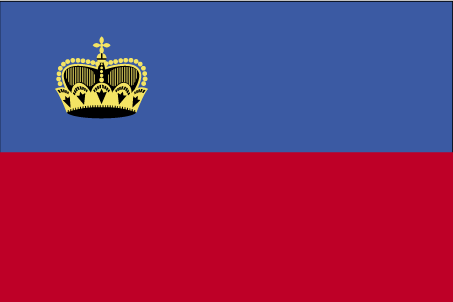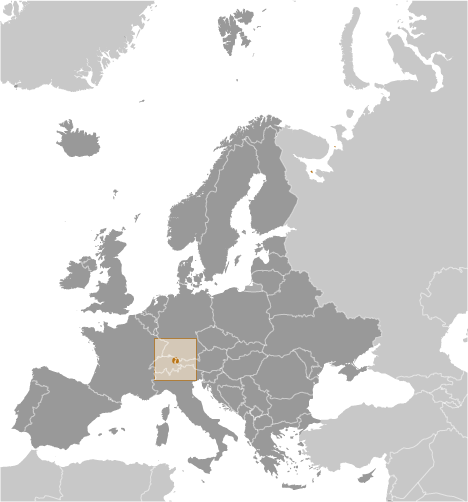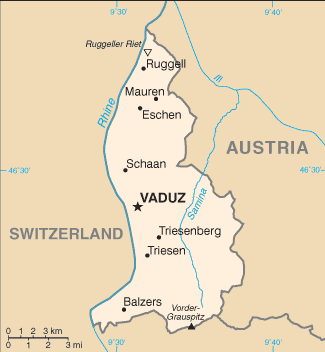Introduction :: LIECHTENSTEIN
-
The Principality of Liechtenstein was established within the Holy Roman Empire in 1719. Occupied by both French and Russian troops during the Napoleonic Wars, it became a sovereign state in 1806 and joined the Germanic Confederation in 1815. Liechtenstein became fully independent in 1866 when the Confederation dissolved. Until the end of World War I, it was closely tied to Austria, but the economic devastation caused by that conflict forced Liechtenstein to enter into a customs and monetary union with Switzerland. Since World War II (in which Liechtenstein remained neutral), the country's low taxes have spurred outstanding economic growth. In 2000, shortcomings in banking regulatory oversight resulted in concerns about the use of financial institutions for money laundering. However, Liechtenstein implemented anti-money laundering legislation and a Mutual Legal Assistance Treaty with the US that went into effect in 2003.
Geography :: LIECHTENSTEIN
-
Central Europe, between Austria and Switzerland
47 16 N, 9 32 E
Europe
total: 160 sq km
land: 160 sq km
water: 0 sq km
country comparison to the world: 219
about 0.9 times the size of Washington, DC
total: 75 km
border countries (2): Austria 34 km, Switzerland 41 km
0 km (doubly landlocked)
none (landlocked)
continental; cold, cloudy winters with frequent snow or rain; cool to moderately warm, cloudy, humid summers
mostly mountainous (Alps) with Rhine Valley in western third
lowest point: Ruggeller Riet 430 m
highest point: Vorder-Grauspitz 2,599 m
hydroelectric potential, arable land
agricultural land: 37.6%
arable land 18.8%; permanent crops 0%; permanent pasture 18.8%
forest: 43.1%
other: 19.3% (2011 est.)
NA
NA
NA
party to: Air Pollution, Air Pollution-Nitrogen Oxides, Air Pollution-Persistent Organic Pollutants, Air Pollution-Sulfur 85, Air Pollution-Sulfur 94, Air Pollution-Volatile Organic Compounds, Biodiversity, Climate Change, Climate Change-Kyoto Protocol, Desertification, Endangered Species, Hazardous Wastes, Ozone Layer Protection, Wetlands
signed, but not ratified: Law of the Sea
along with Uzbekistan, one of only two doubly landlocked countries in the world; variety of microclimatic variations based on elevation
People and Society :: LIECHTENSTEIN
-
noun: Liechtensteiner(s)
adjective: Liechtenstein
Liechtensteiner 66.3%, other 33.7% (2013 est.)
German 94.5% (official) (Alemannic is the main dialect), Italian 1.1%, other 4.3% (2010 est.)
Roman Catholic (official) 75.9%, Protestant Reformed 6.5%, Muslim 5.4%, Lutheran 1.3%, other 2.9%, none 5.4%, unspecified 2.6% (2010 est.)
37,624 (July 2015 est.)
country comparison to the world: 214
0-14 years: 15.54% (male 3,142/female 2,706)
15-24 years: 11.73% (male 2,182/female 2,230)
25-54 years: 42.65% (male 8,013/female 8,035)
55-64 years: 13.58% (male 2,504/female 2,606)
65 years and over: 16.49% (male 2,837/female 3,369) (2015 est.)
population pyramid:

total: 42.7 years
male: 41.5 years
female: 43.8 years (2015 est.)
0.84% (2015 est.)
country comparison to the world: 130
10.45 births/1,000 population (2015 est.)
country comparison to the world: 187
7.12 deaths/1,000 population (2015 est.)
country comparison to the world: 128
5.08 migrant(s)/1,000 population (2015 est.)
country comparison to the world: 26
urban population: 14.3% of total population (2015)
rate of urbanization: 0.48% annual rate of change (2010-15 est.)
VADUZ (capital) 5,000 (2014)
at birth: 1.26 male(s)/female
0-14 years: 1.16 male(s)/female
15-24 years: 0.98 male(s)/female
25-54 years: 1 male(s)/female
55-64 years: 0.96 male(s)/female
65 years and over: 0.84 male(s)/female
total population: 0.99 male(s)/female (2015 est.)
total: 4.29 deaths/1,000 live births
male: 4.59 deaths/1,000 live births
female: 3.92 deaths/1,000 live births (2015 est.)
country comparison to the world: 189
total population: 81.77 years
male: 79.6 years
female: 84.5 years (2015 est.)
country comparison to the world: 16
1.69 children born/woman (2015 est.)
country comparison to the world: 173
NA
NA
NA
2.1% of GDP (2008)
country comparison to the world: 166
total: 15 years
male: 16 years
female: 14 years (2012)
Government :: LIECHTENSTEIN
-
conventional long form: Principality of Liechtenstein
conventional short form: Liechtenstein
local long form: Fuerstentum Liechtenstein
local short form: Liechtenstein
hereditary constitutional monarchy
name: Vaduz
geographic coordinates: 47 08 N, 9 31 E
time difference: UTC+1 (6 hours ahead of Washington, DC, during Standard Time)
daylight saving time: +1hr, begins last Sunday in March; ends last Sunday in October
11 communes (Gemeinden, singular - Gemeinde); Balzers, Eschen, Gamprin, Mauren, Planken, Ruggell, Schaan, Schellenberg, Triesen, Triesenberg, Vaduz
23 January 1719 (Principality of Liechtenstein established); 12 July 1806 (independence from the Holy Roman Empire); 24 August 1866 (independence from the German Confederation)
Assumption Day, 15 August, and National Day, 15 August (1940)
previous 1862; latest adopted 5 October 1921; amended many times, last in 2011 (2015)
civil law system influenced by Swiss, Austrian, and German law
accepts compulsory ICJ jurisdiction with reservations; accepts ICCt jurisdiction
citizenship by birth: no
citizenship by descent only: the father must be a citizen of Liechtenstein; in the case of a child born out of wedlock, the mother must be a citizen
dual citizenship recognized: no
residency requirement for naturalization: 5 years
18 years of age; universal
chief of state: Prince HANS ADAM II (since 13 November 1989, assumed executive powers on 26 August 1984); Heir Apparent Prince ALOIS, son of the monarch (born 11 June 1968); note - on 15 August 2004, HANS ADAM II transferred the official duties of the ruling prince to ALOIS, but HANS ADAM II retains status of chief of state
head of government: Prime Minister Adrian HASLER (since 27 March 2013)
cabinet: Cabinet elected by the Parliament, confirmed by the monarch
elections/appointments: the monarchy is hereditary; following legislative elections, the leader of the majority party in the Landtag usually appointed the head of government by the monarch, and the leader of the largest minority party in the Landtag usually appointed the deputy head of government by the monarch if there is a coalition government
description: unicameral Parliament or Landtag (25 seats; members directly elected in multi-seat constituencies by proportional representation vote to serve 4-year terms)
elections: last held on 3 February 2013 (next to be held in February 2017)
election results: percent of vote by party - FBP 40.0%, VU 33.5%, DU 15.3% FL 11.1%; seats by party - FBP 10, VU 8, DU 4, FL 3
highest court(s): Supreme Court or Oberster Gerichtshof (consists of 5 judges); Constitutional Court or Verfassungsgericht (consists of 5 judges and 5 alternates)
judge selection and term of office: judges of both courts elected by the Landtag and appointed by the monarch; Supreme Court judges serve 4-year renewable terms; Constitutional Court judge tenure NA
subordinate courts: Court of Appeal or Obergericht (second instance), Court of Justice (first instance), Administrative Court, county courts
Fatherland Union (Vaterlaendische Union) or VU [Jakob BUECHEL]
Progressive Citizens' Party (Fortschrittliche Buergerpartei) or FBP [Elfried HASLER]
The Free List (Die Freie Liste) or FL [Wolfgang MARXER]
the independents (Die Unabhaengigen) or DU [Harry QUADERER]
CD, CE, EBRD, EFTA, IAEA, ICCt, ICRM, IFRCS, Interpol, IOC, IPU, ITSO, ITU, ITUC (NGOs), OAS (observer), OPCW, OSCE, PCA, Schengen Convention, UN, UNCTAD, UPU, WIPO, WTO
chief of mission: Ambassador Claudia FRITSCHE (since 7 December 2000)
chancery: 2900 K Street, NW, Suite 602B, Washington, DC 20007
telephone: [1] (202) 331-0590
FAX: [1] (202) 331-3221
consulate(s) general: Atlanta, New York, San Francisco
the US does not have an embassy in Liechtenstein; the US Ambassador to Switzerland is accredited to Liechtenstein
two equal horizontal bands of blue (top) and red with a gold crown on the hoist side of the blue band; the colors may derive from the blue and red livery design used in the principality's household in the 18th century; the prince's crown was introduced in 1937 to distinguish the flag from that of Haiti
princely hat (crown); national colors: blue, red
name: "Oben am jungen Rhein" (High Above the Young Rhine)
lyrics/music: Jakob Joseph JAUCH/Josef FROMMELT
note: adopted 1850, revised 1963; uses the tune of "God Save the Queen"
Economy :: LIECHTENSTEIN
-
Despite its small size and limited natural resources, Liechtenstein has developed into a prosperous, highly industrialized, free-enterprise economy with a vital financial service sector and the third highest per capita income in the world, after Qatar and Luxembourg. The Liechtenstein economy is widely diversified with a large number of small businesses. Low business taxes - the maximum tax rate is 20% - and easy incorporation rules have induced many holding companies to establish nominal offices in Liechtenstein, providing 30% of state revenues. The country participates in a customs union with Switzerland and uses the Swiss franc as its national currency. It imports more than 90% of its energy requirements. Liechtenstein has been a member of the European Economic Area (an organization serving as a bridge between the European Free Trade Association (EFTA) and the EU) since May 1995. The government is working to harmonize its economic policies with those of an integrated Europe. Since 2008, Liechtenstein has faced renewed international pressure - particularly from Germany and the United States - to improve transparency in its banking and tax systems. In December 2008, Liechtenstein signed a Tax Information Exchange Agreement with the US. Upon Liechtenstein's conclusion of 12 bilateral information-sharing agreements, the OECD in October 2009 removed the principality from its "grey list" of countries that had yet to implement the organization's Model Tax Convention. By the end of 2010, Liechtenstein had signed 25 Tax Information Exchange Agreements or Double Tax Agreements. In 2011 Liechtenstein joined the Schengen area, which allows passport-free travel across 26 European countries.
$3.2 billion (2009 est.)
$3.216 billion (2008 est.)
$3.159 billion (2007 est.)
country comparison to the world: 182
$5.113 billion (2010 est.)
1.8% (2012 est.)
-0.5% (2009 est.)
3.1% (2007 est.)
country comparison to the world: 156
$89,400 (2009 est.)
$90,600 (2008 est.)
$89,700 (2007 est.)
country comparison to the world: 3
agriculture: 8%
industry: 37%
services: 55% (2009)
wheat, barley, corn, potatoes; livestock, dairy products
electronics, metal manufacturing, dental products, ceramics, pharmaceuticals, food products, precision instruments, tourism, optical instruments
NA%
35,830 (2012)
note: 51% of the labor force in Liechtenstein commute daily from Austria, Switzerland, or Germany (2012 est.)
country comparison to the world: 201
agriculture: 0.8%
industry: 39.4%
services: 59.9% (2012)
2.3% (2012)
2.5% (2011)
country comparison to the world: 15
NA%
lowest 10%: NA%
highest 10%: NA%
revenues: $995.3 million
expenditures: $890.4 million (2011 est.)
19.5% of GDP (2012 est.)
country comparison to the world: 168
2.1% of GDP (2012 est.)
country comparison to the world: 18
calendar year
-0.7% (2012)
0.2% (2011)
country comparison to the world: 11
$NA
$3.801 billion (2012 est.)
$3.757 billion (2011 est.)
note: trade data exclude trade with Switzerland
country comparison to the world: 124
small specialty machinery, connectors for audio and video, parts for motor vehicles, dental products, hardware, prepared foodstuffs, electronic equipment, optical products
$2.09 billion (2012 est.)
$2.218 billion (2011 est.)
note: trade data exclude trade with Switzerland
country comparison to the world: 161
agricultural products, raw materials, energy products, machinery, metal goods, textiles, foodstuffs, motor vehicles
$0 (2001)
note: public external debt only; private external debt unavailable
country comparison to the world: 206
Swiss francs (CHF) per US dollar -
0.9152 (2014)
0.9377 (2012)
0.94 (2012 est.)
0.8876 (2011 est.)
1.0429 (2010 est.)
Energy :: LIECHTENSTEIN
-
145.3 million kWh (2012)
country comparison to the world: 193
1.36 billion kWh (2012)
country comparison to the world: 149
1.214 billion kWh (2012)
country comparison to the world: 59
Communications :: LIECHTENSTEIN
-
total subscriptions: 18,000
subscriptions per 100 inhabitants: 48 (2014 est.)
country comparison to the world: 187
total: 38,800
subscriptions per 100 inhabitants: 104 (2014 est.)
country comparison to the world: 204
general assessment: automatic telephone system
domestic: fixed-line and mobile-cellular services widely available; combined telephone service subscribership exceeds 150 per 100 persons
international: country code - 423; linked to Swiss networks by cable and microwave radio relay (2011)
relies on foreign terrestrial and satellite broadcasters for most broadcast media services; first Liechtenstein-based TV station established August 2008; Radio Liechtenstein operates multiple radio stations; a Swiss-based broadcaster operates several radio stations in Liechtenstein (2008)
AM 0, FM 4, shortwave 0 (1998)
NA (linked to Swiss networks) (1997)
.li
total: 34,500
percent of population: 92.4% (2014 est.)
country comparison to the world: 193
Transportation :: LIECHTENSTEIN
-
gas 20 km (2013)
total: 9 km
standard gauge: 9 km 1.435-m gauge (electrified)
note: belongs to the Austrian Railway System connecting Austria and Switzerland (2008)
country comparison to the world: 136
total: 380 km
paved: 380 km (2012)
country comparison to the world: 202
28 km (2010)
country comparison to the world: 105
Military :: LIECHTENSTEIN
-
no regular military forces; National Police maintains close relations with neighboring forces (2013)
males age 16-49: 8,009 (2010 est.)
males age 16-49: 6,538
females age 16-49: 6,746 (2010 est.)
male: 219
female: 211 (2010 est.)
Liechtenstein has no military forces, but the modern National Police maintains close relations with neighboring forces (2013)
Transnational Issues :: LIECHTENSTEIN
-
none
has strengthened money laundering controls, but money laundering remains a concern due to Liechtenstein's sophisticated offshore financial services sector
 Central Intelligence Agency
Central Intelligence Agency





